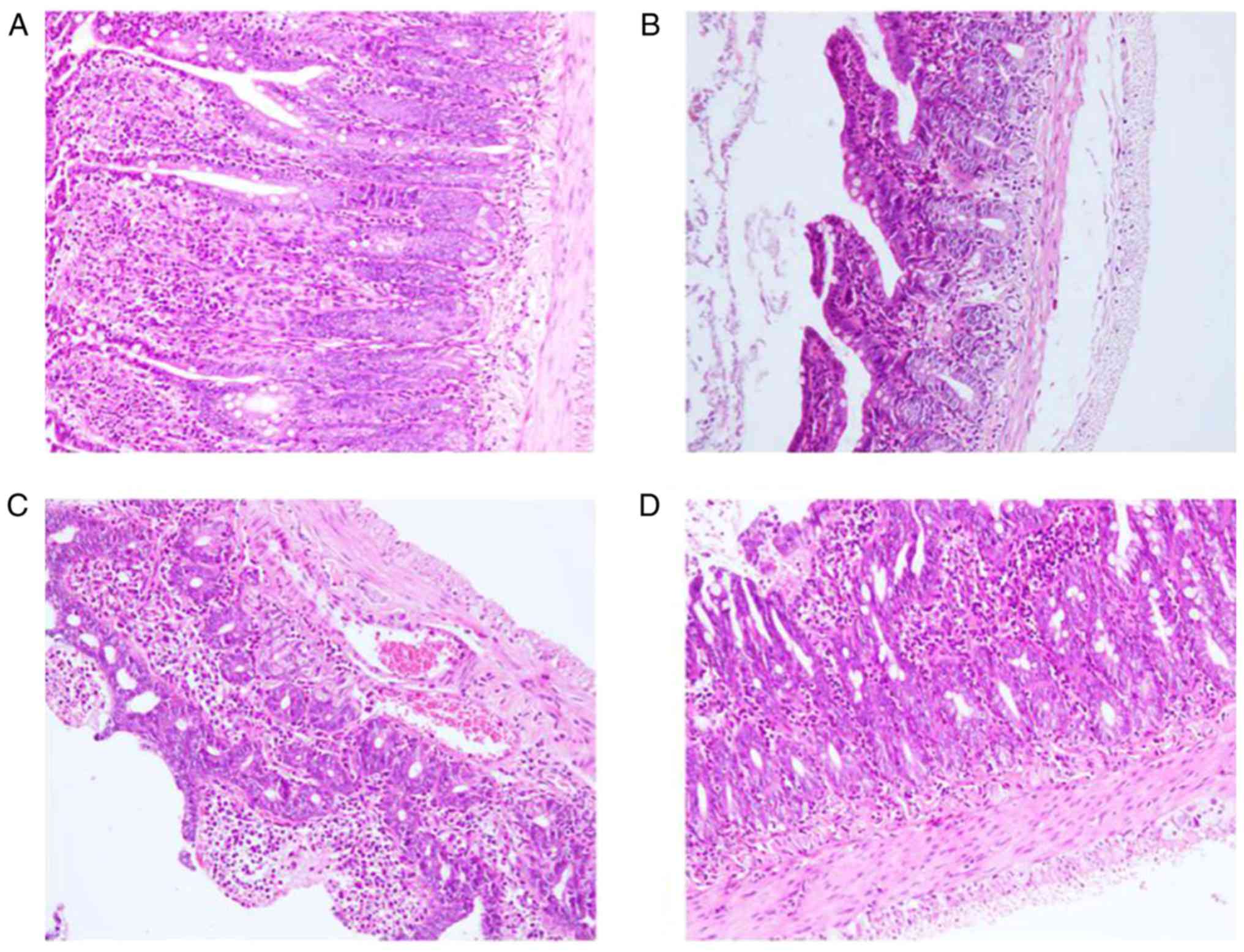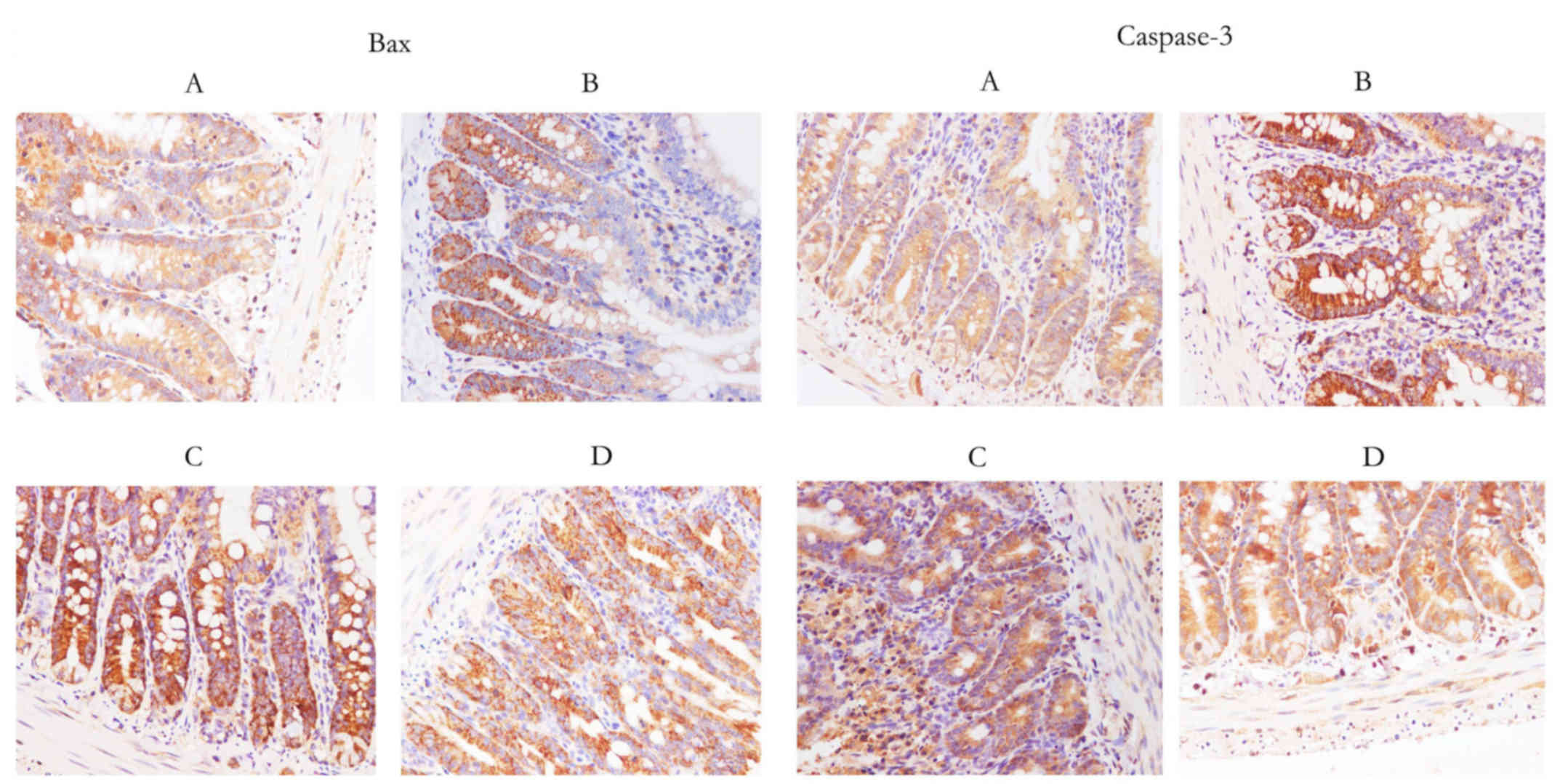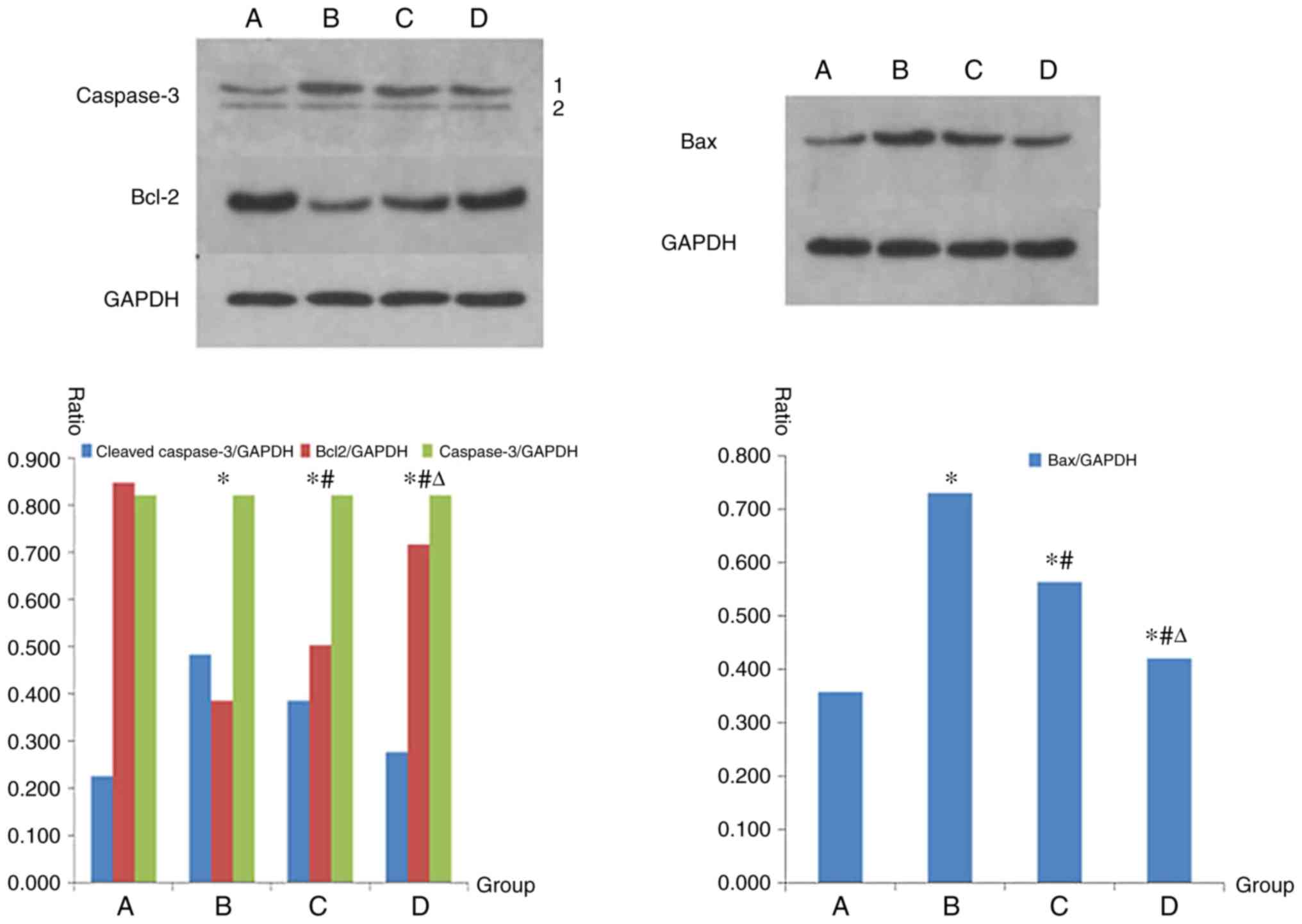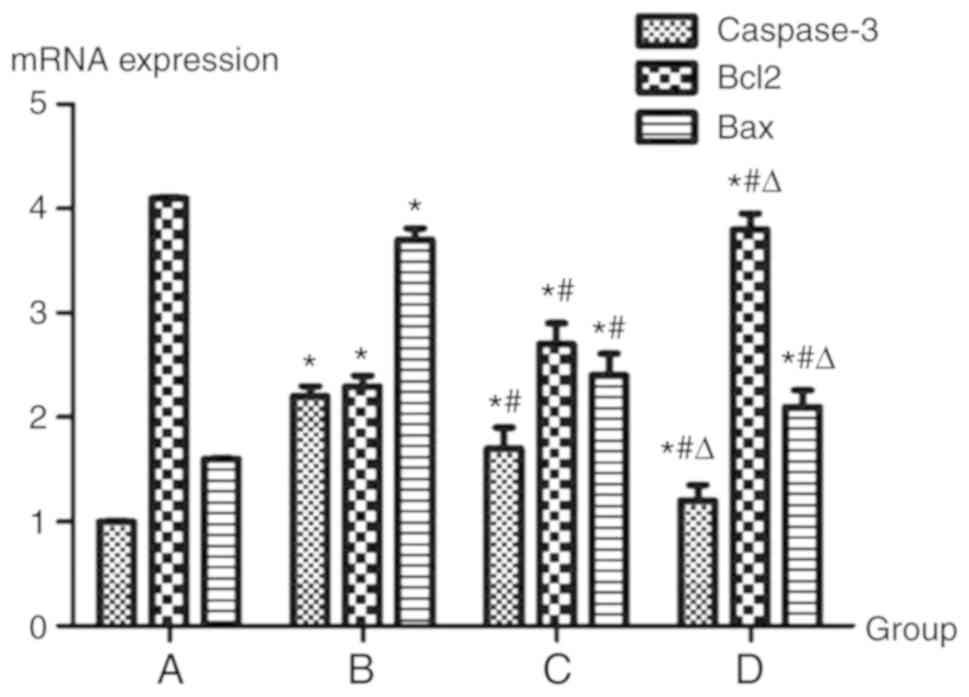|
1
|
Nadatani Y, Watanabe T, Shimada S, Otani
K, Tanigawa T and Fujiwara Y: Microbiome and intestinal
ischemia/reperfusion injury. J Clin Biochem Nutr. 63:26–32. 2018.
View Article : Google Scholar : PubMed/NCBI
|
|
2
|
Bradbury AW, Brittenden J, McBride K and
Ruckley CV: Mesenteric ischaemia: A multidisciplinary approach. Br
J Surg. 82:1446–1459. 1995. View Article : Google Scholar : PubMed/NCBI
|
|
3
|
van Wijck K, Lenaerts K, van Loon LJ,
Peters WH, Buurman WA and Dejong CH: Exercise-induced splanchnic
hypoperfusion results in gut dysfunction in healthy men. PLoS One.
6:e223662011. View Article : Google Scholar : PubMed/NCBI
|
|
4
|
Hatoum OA, Binion DG, Otterson MF and
Gutterman DD: Acquired microvascular dysfunction in inflammatory
bowel disease: Loss of nitric oxide-mediated vasodilation.
Gastroenterology. 125:58–69. 2003. View Article : Google Scholar : PubMed/NCBI
|
|
5
|
Lin ZL, Yu WK, Tan SJ, Duan KP, Dong Y,
Bai XW, Xu L and Li N: Protective effects of terminal ileostomy
against bacterial translocation in a rat model of intestinal
ischemia/reperfusion injury. World J Gastroenterol. 20:17905–17913.
2014. View Article : Google Scholar : PubMed/NCBI
|
|
6
|
Yasuhara H: Acute mesenteric ischemia: The
challenge of gastroenterology. Surg Today. 35:185–195. 2005.
View Article : Google Scholar : PubMed/NCBI
|
|
7
|
Granger DN, Richardson PD, Kvietys PR and
Mortillaro NA: Intestinal blood flow. Gastroenterology. 78:837–863.
1980. View Article : Google Scholar : PubMed/NCBI
|
|
8
|
Parks DA and Granger DN: Contributions of
ischemia and reperfusion to mucosal lesion formation. Am J Physiol.
250:G749–G753. 1986.PubMed/NCBI
|
|
9
|
Li L, Whiteman M, Guan YY, Neo KL, Cheng
Y, Lee SW, Zhao Y, Baskar R, Tan CH and Moore PK: Characterization
of a novel, water-soluble hydrogen sulfide-releasing
molecule(gyy4137): New insights into the biology of hydrogen
sulfide. Circulation. 117:2351–2360. 2008. View Article : Google Scholar : PubMed/NCBI
|
|
10
|
Hayley Robinson and Susan Wray: A new slow
releasing, H2S generating compound, GYY4137 relaxes spontaneous and
oxytocin-stimulated contractions of human and rat pregnant
myometrium. PLoS One. 7:e46272012.
|
|
11
|
Wei WB, Hu X, Zhuang XD, Liao LZ and Li
WD: GYY4137, a novel hydrogen sulfide-releasing molecule, likely
protects against high glucose-induced cytotoxicity by activation of
the AMPK/mTOR signal pathway in H9c2 cells. Mol Cell Biochem.
389:249–256. 2014. View Article : Google Scholar : PubMed/NCBI
|
|
12
|
Liu Z, Han Y, Li L, Lu H, Meng G, Li X,
Shirhan M, Peh MT, Xie L, Zhou S, et al: The hydrogen sulfide
donor, GYY4137, exhibits anti-atherosclerotic activity in high fat
fed apolipoprotein E(−/-) mice. Br J Pharmacol. 169:1795–1809.
2013. View Article : Google Scholar : PubMed/NCBI
|
|
13
|
Bernth Jensen JM, Petersen MS, Stegger M,
Østergaard LJ and Møller BK: Real-time relative qPCR without
reference to control samples and estimation of run-specific PCR
parameters from run-internal mini-standard curves. PLoS One.
5:e117232010. View Article : Google Scholar : PubMed/NCBI
|
|
14
|
Galaly SR, Ahmed OM and Mahmoud AM:
Thymoquinone and curcumin prevent gentamicin-induced liver injury
by attenuating oxidative stress, inflammation and apoptosis. J
Physiol Pharmacol. 65:823–832. 2014.PubMed/NCBI
|
|
15
|
Shao YY, Li B, Huang YM, Luo Q, Xie YM and
Chen YH: Thymoquinone attenuates brain injury via an anti-oxidative
pathway in a status epilepticus rat model. Transl Neurosci. 8:9–14.
2017. View Article : Google Scholar : PubMed/NCBI
|
|
16
|
Jiang D, Wu D, Zhang Y, Xu B, Sun X and Li
Z: Protective effects of hydrogen rich saline solution on
experimental testicular ischemia-reperfusion injury in rats. J
Urol. 187:2249–2253. 2012. View Article : Google Scholar : PubMed/NCBI
|
|
17
|
Cobourne-Duval MK, Taka E, Mendonca P,
Bauer D and Soliman KF: The antioxidant effects of thymoquinone in
activated BV-2 murine microglial cells. Neurochem Res.
41:3227–3238. 2016. View Article : Google Scholar : PubMed/NCBI
|
|
18
|
Karimian A, Ahmadi Y and Yousefi B:
Multiple functions of p21 in cell cycle, apoptosis and
transcriptional regulation after DNA damage. DNA Repair (Amst).
42:63–71. 2016. View Article : Google Scholar : PubMed/NCBI
|
|
19
|
Zhang ZX, Shek K, Wang S, Huang X, Lau A,
Yin Z, Sun H, Liu W, Garcia B, Rittling S and Jevnikar AM:
Osteopontin expressed in tubular epithelial cells regulates NK
cell-mediated kidney ischemia reperfusion injury. J Immunol.
185:967–973. 2010. View Article : Google Scholar : PubMed/NCBI
|
|
20
|
Kojima M, Iwakiri R, Wu B, Fujise T,
Watanabe K, Lin T, Amemori S, Sakata H, Shimoda R, Oguzu T, et al:
Effects of antioxidative agents on apoptosis induced by
ischaemia-reperfusion in rat intestinal mucosa. Aliment Pharmacol
Ther. 18 (Suppl 1):S139–S145. 2003. View Article : Google Scholar
|
|
21
|
Arnoult D, Parone P, Martinou JC,
Antonsson B, Estaquier J and Ameisen JC: Mitochondrial release of
apoptosis-inducing factor occurs downstream of cytochrome c release
in response to several proapoptotic stimuli. J Cell Biol.
159:923–929. 2002. View Article : Google Scholar : PubMed/NCBI
|
|
22
|
Guo J, Wang SB, Yuan TY, Wu YJ, Yan Y, Li
L, Xu XN, Gong LL, Qin HL, Fang LH and Du GH: Coptisine protects
rat heart against myocardial ischemia/reperfusion injury by
suppressing myocardial apoptosis and inflammation. Atherosclerosis.
231:384–391. 2013. View Article : Google Scholar : PubMed/NCBI
|
|
23
|
Moya A, Sakamaki K, Mason BM, Huisman L,
Forêt S, Weiss Y, Bull TE, Tomii K, Imai K, Hayward DC, et al:
Functional conservation of the apoptotic machinery from coral to
man: The diverse and complex Bcl-2 and caspase repertoires of
Acropora millepora. BMC Genomics. 17:622016. View Article : Google Scholar : PubMed/NCBI
|



















